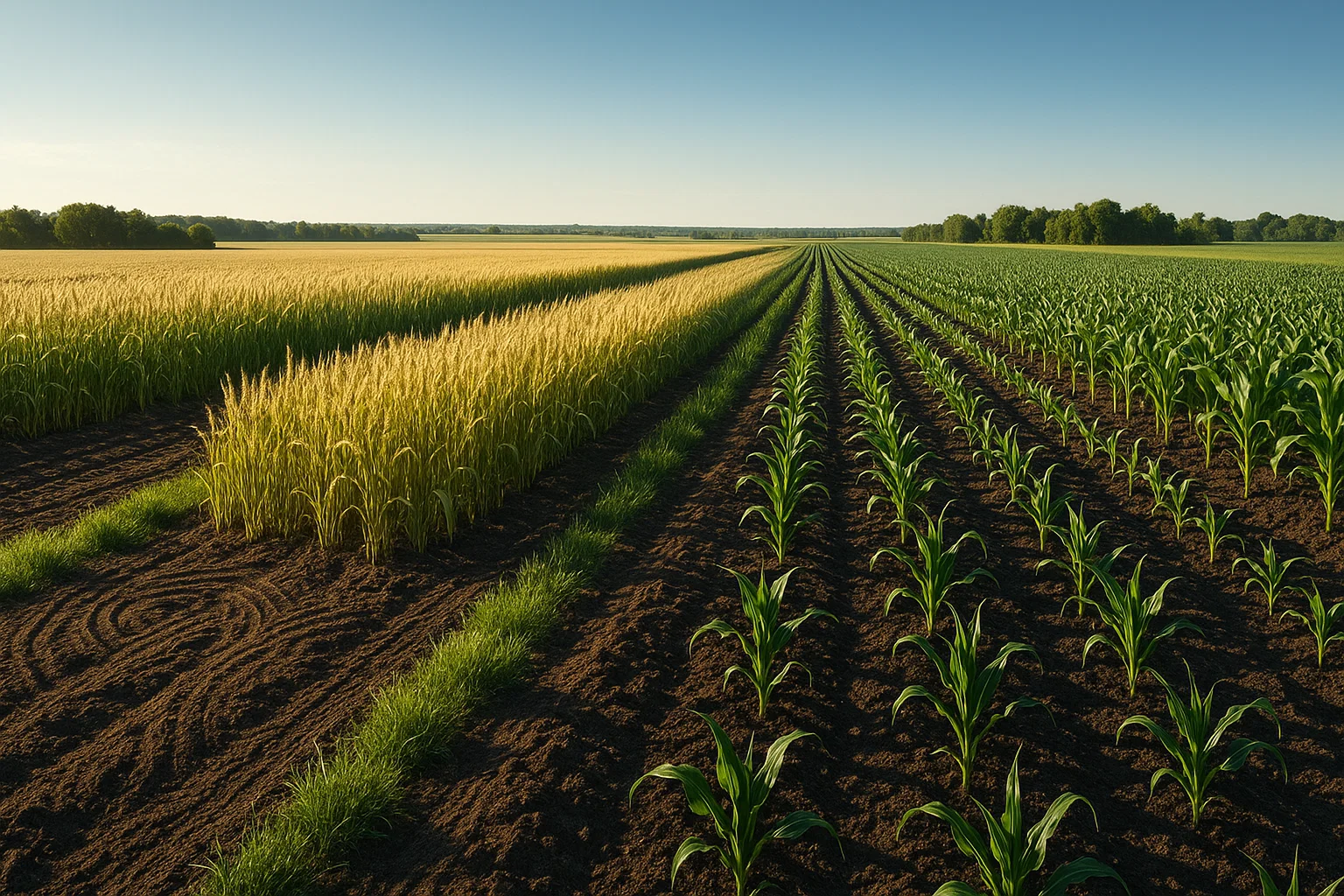Arable land, an essential resource for food production, plays a critical role in sustaining life on Earth. This finite asset has increasingly become the subject of concern due to its rapid depletion.
In this article, FnB Tech will explore the concept of arable land, its importance in agriculture, and why it is rapidly vanishing. Understanding the pressures on arable land and its consequences is vital for addressing global food security.
Contents
What Is Arable Land?
Arable land refers to land that is suitable for growing crops. This land is typically fertile, with well-drained soil and a favorable climate that supports agriculture. The most common crops grown on fertile land include grains such as wheat, rice, and corn, as well as vegetables, fruits, and legumes.
The term “arable” is derived from the Latin word arabilis, meaning “able to be ploughed.” While arable land can be used for both crop cultivation and livestock grazing, its primary function is to support plant-based agriculture.
Read also: Why Lease Land Could Be Your Best Investment Yet
What Does Arable Land Mean in the Context of Global Agriculture?
In the context of global agriculture, arable land is not just a space where crops are grown; it represents the backbone of the world’s food system. This land supports the global agricultural industry, which feeds billions of people worldwide.
Fertile land is also crucial for economic development, especially in countries where agriculture is the primary source of income for a large portion of the population. For many nations, the ability to expand and maintain arable land directly influences their economic prosperity and food security.
Why Is Arable Land Important?
Arable land is essential for several reasons:
-
Food Security: It is the primary source of food production for a growing global population.
-
Economic Value: Agriculture generates employment and income, especially in rural areas.
-
Environmental Health: Sustainable management of fertile land helps maintain biodiversity and ecosystem services such as soil fertility and water retention.
The Global Decrease in Arable Land

Unfortunately, fertile land is becoming increasingly scarce. According to various reports, the world is losing arable land at an alarming rate.
This is due to a combination of factors, including urbanization, soil degradation, climate change, and industrial farming practices. The depletion of arable land threatens food security, particularly in regions that rely heavily on local crop production.
1. Urbanization and Industrialization
Urbanization is one of the leading causes of the reduction in fertile land. As cities expand, large areas of agricultural land are converted into residential, commercial, and industrial zones. In many developing countries, agricultural land is being encroached upon to accommodate a rapidly growing urban population.
As cities sprawl, the pressure on arable land increases, leading to a loss of farmland that could have been used for food production. Moreover, industrialization often leads to the development of infrastructure that damages ecosystems and reduces the productivity of land that is still available.
2. Soil Degradation
Soil degradation, caused by overuse and poor land management practices, is another significant factor contributing to the loss of arable land. As farmers over-cultivate the land without replenishing its nutrients, soil quality deteriorates, making it less suitable for crop production.
Erosion, salinization, and desertification further exacerbate the problem. These processes strip the soil of vital nutrients and water-holding capacity, making it increasingly difficult to grow crops. In many parts of the world, land that was once arable is no longer able to support agriculture due to soil degradation.
3. Climate Change
Climate change has emerged as a major threat to fertile land. The changing climate is causing shifts in temperature, rainfall patterns, and the frequency of extreme weather events. These changes make certain regions less suitable for growing crops, leading to a decline in available fertile land.
For example, areas that traditionally had reliable rainfall may experience prolonged droughts, while regions with stable climates may be hit by severe flooding. In addition, increased temperatures can cause crop failure and decrease agricultural productivity.
4. Agricultural Expansion
While expanding agriculture to meet the growing demand for food may seem like a solution, it often leads to further environmental harm. In many cases, forests are cleared to make way for agricultural development, reducing biodiversity and increasing greenhouse gas emissions.
Intensive farming techniques, such as monocropping, contribute to the depletion of soil nutrients, further reducing the land’s ability to remain arable. The overuse of pesticides and fertilizers can also harm the ecosystem and make the land less fertile over time.
Read also: What is Carbon Farming? Exploring Its Role in Sustainable Agriculture
The Implications of Vanishing Arable Land
The consequences of the loss of cultivable land are far-reaching. As available farmland dwindles, food production becomes increasingly difficult. The world faces the challenge of feeding an estimated 10 billion people by 2050, a goal that becomes harder to achieve as arable land disappears.
1. Food Insecurity
The shrinking of fertile land directly contributes to food insecurity. With less land available for farming, countries must rely more heavily on imports, which can drive up food prices.
In regions where food production is already limited, the loss of arable land exacerbates poverty and malnutrition.
2. Increased Pressure on Remaining Land
As arable land becomes scarcer, the remaining fertile areas face increasing pressure to produce more crops. This intensifies farming practices, which can lead to soil depletion, water scarcity, and environmental degradation.
3. Loss of Biodiversity
The conversion of cultivable land into urban or industrial spaces often leads to the destruction of ecosystems and the loss of biodiversity. Forests, wetlands, and other natural habitats are cleared to make way for agriculture or urban development, causing irreparable harm to wildlife populations and ecosystem services.
How Can We Prevent the Loss of Fertile Land?
Addressing the issue of vanishing fertile land requires a multi-faceted approach that balances food production with environmental sustainability. Below are some strategies to help preserve arable land for future generations:
1. Sustainable Agriculture
One of the most effective ways to preserve fertile land is through sustainable farming practices. This includes crop rotation, reduced pesticide use, and soil conservation techniques that maintain the health and fertility of the land.
Agroforestry and organic farming are examples of methods that help replenish the soil and increase biodiversity.
2. Land Restoration
Efforts to restore degraded land can help reverse some of the damage done to arable land. Techniques such as reforestation, soil erosion control, and desertification prevention can help regenerate soil health and make previously unproductive land suitable for farming again.
3. Urban Planning and Land Use Regulation
Careful urban planning that takes into account the preservation of agricultural land is essential. Governments can implement policies that protect farmland from urban sprawl, such as zoning laws, green belts, and incentives for sustainable farming.
4. Reducing Food Waste
Another way to address the challenge of vanishing arable land is to reduce food waste. A significant portion of food produced worldwide is wasted, which places unnecessary pressure on the land and resources required for food production.
By reducing food waste, we can make better use of the existing land available for cultivation.
Conclusion
The issue of vanishing arable land is a pressing concern that requires immediate attention. With rapid urbanization, soil degradation, climate change, and unsustainable agricultural practices contributing to the loss of arable land, it is clear that the current trajectory is unsustainable.
The preservation of fertile land is essential for ensuring global food security and maintaining environmental balance. By adopting sustainable agricultural practices, restoring degraded land, and implementing effective land use policies, we can protect this invaluable resource for future generations.
Ultimately, the responsibility lies with governments, businesses, and individuals to recognize the importance of arable land and take proactive measures to safeguard it. The future of food production depends on how we choose to manage the land we have left.
Pippo is passionate about coffee beans, exploring their unique varieties and cultural significance. He has a strong interest in agritech, focusing on innovations that drive sustainable farming. Beyond agriculture, he is also dedicated to the field of aquaculture and its future potential. His curiosity and enthusiasm connect these fields, reflecting a commitment to sustainability and growth.


